2016 KIA PICANTO climate control
[x] Cancel search: climate controlPage 404 of 488
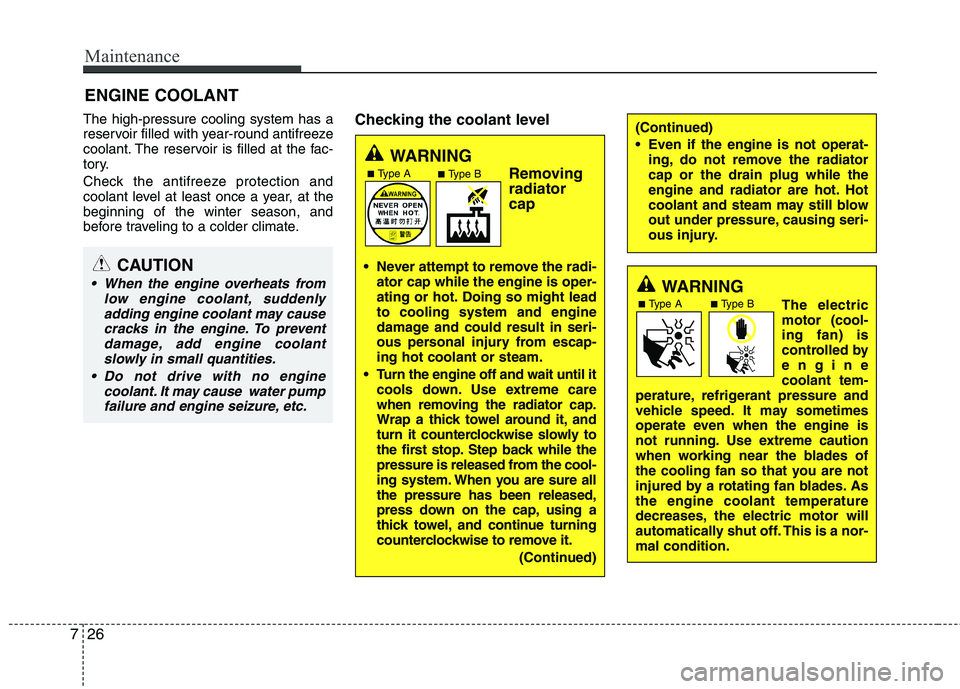
Maintenance
26
7
ENGINE COOLANT
The high-pressure cooling system has a
reservoir filled with year-round antifreeze
coolant. The reservoir is filled at the fac-
tory.
Check the antifreeze protection and
coolant level at least once a year, at thebeginning of the winter season, and
before traveling to a colder climate. Checking the coolant level
WARNING
Removingradiator cap
Never attempt to remove the radi- ator cap while the engine is oper-
ating or hot. Doing so might leadto cooling system and engine
damage and could result in seri-
ous personal injury from escap-ing hot coolant or steam.
Turn the engine off and wait until it cools down. Use extreme care
when removing the radiator cap.
Wrap a thick towel around it, and
turn it counterclockwise slowly to
the first stop. Step back while the
pressure is released from the cool-
ing system. When you are sure allthe pressure has been released,
press down on the cap, using a
thick towel, and continue turning
counterclockwise to remove it.
(Continued)
(Continued)
Even if the engine is not operat-ing, do not remove the radiator cap or the drain plug while the
engine and radiator are hot. Hot
coolant and steam may still blow
out under pressure, causing seri-
ous injury.
WARNING
The electric motor (cool-ing fan) is
controlled byenginecoolant tem-
perature, refrigerant pressure and
vehicle speed. It may sometimes
operate even when the engine is
not running. Use extreme caution
when working near the blades of
the cooling fan so that you are not
injured by a rotating fan blades. Asthe engine coolant temperature
decreases, the electric motor will
automatically shut off. This is a nor-mal condition.
CAUTION
When the engine overheats from
low engine coolant, suddenly
adding engine coolant may causecracks in the engine. To preventdamage, add engine coolant slowly in small quantities.
Do not drive with no engine coolant. It may cause water pumpfailure and engine seizure, etc.
■ Type B■Type A
■ Type B■Type A
Page 413 of 488
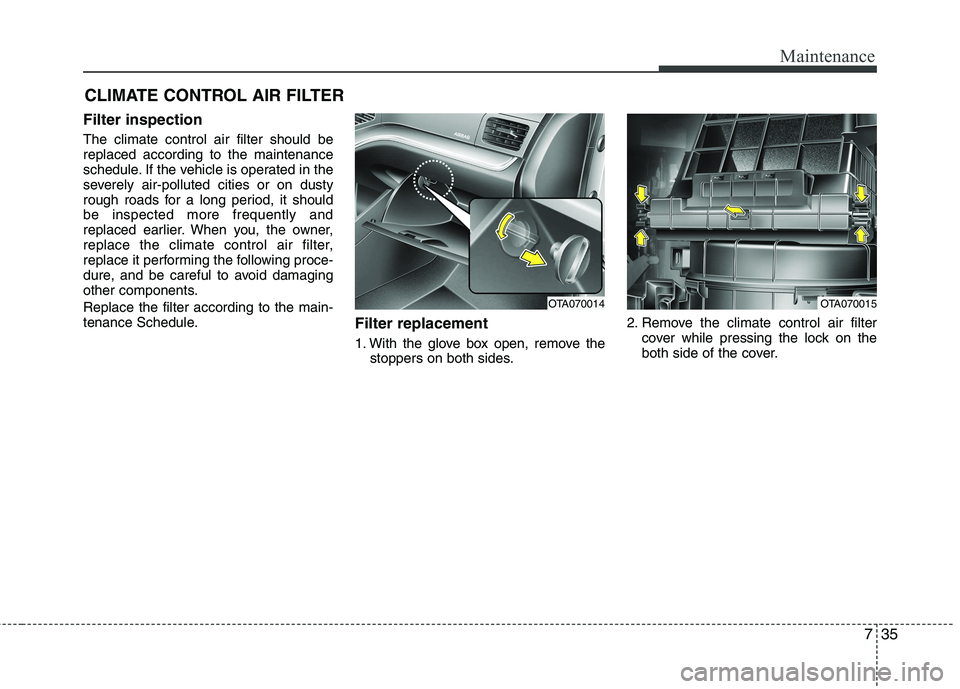
735
Maintenance
CLIMATE CONTROL AIR FILTER
Filter inspection The climate control air filter should be replaced according to the maintenance
schedule. If the vehicle is operated in the
severely air-polluted cities or on dusty
rough roads for a long period, it shouldbe inspected more frequently and
replaced earlier. When you, the owner,
replace the climate control air filter,
replace it performing the following proce-
dure, and be careful to avoid damaging
other components. Replace the filter according to the main-
tenance Schedule. Filter replacement
1. With the glove box open, remove the
stoppers on both sides. 2. Remove the climate control air filter
cover while pressing the lock on the
both side of the cover.
OTA070015OTA070014
Page 414 of 488
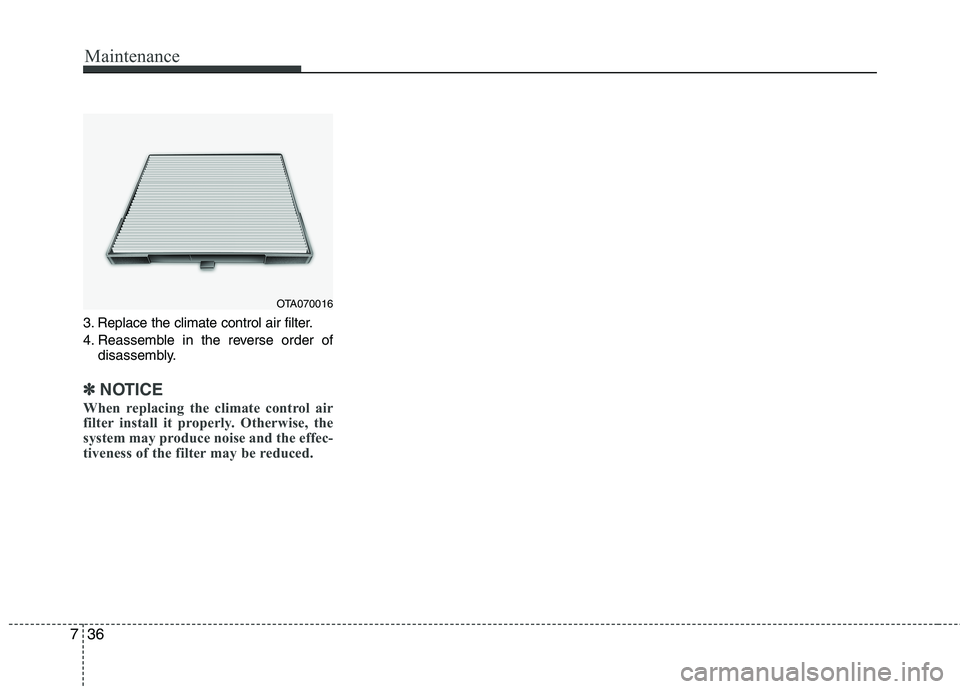
Maintenance
36
7
3. Replace the climate control air filter.
4. Reassemble in the reverse order of
disassembly.
✽✽ NOTICE
When replacing the climate control air
filter install it properly. Otherwise, the
system may produce noise and the effec-
tiveness of the filter may be reduced.
OTA070016
Page 421 of 488
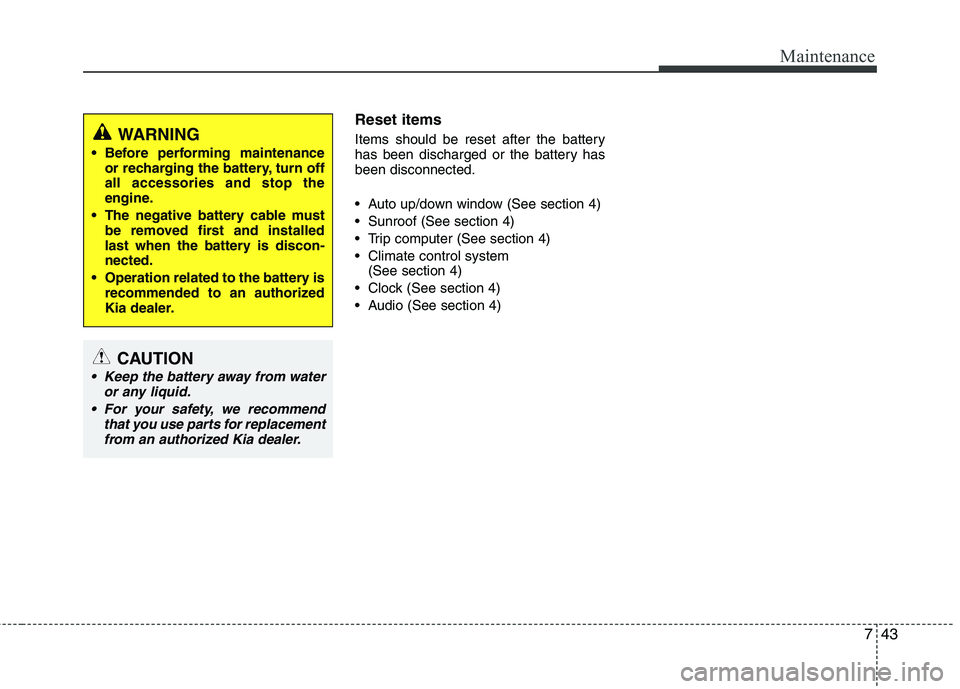
743
Maintenance
Reset items
Items should be reset after the battery
has been discharged or the battery hasbeen disconnected.
Auto up/down window (See section 4)
Sunroof (See section 4)
Trip computer (See section 4)
Climate control system (See section 4)
Clock (See section 4)
Audio (See section 4)
WARNING
Before performing maintenance or recharging the battery, turn off all accessories and stop the
engine.
The negative battery cable must be removed first and installed
last when the battery is discon-nected.
Operation related to the battery is recommended to an authorized
Kia dealer.
CAUTION
Keep the battery away from water
or any liquid.
For your safety, we recommend that you use parts for replacementfrom an authorized Kia dealer.
Page 429 of 488
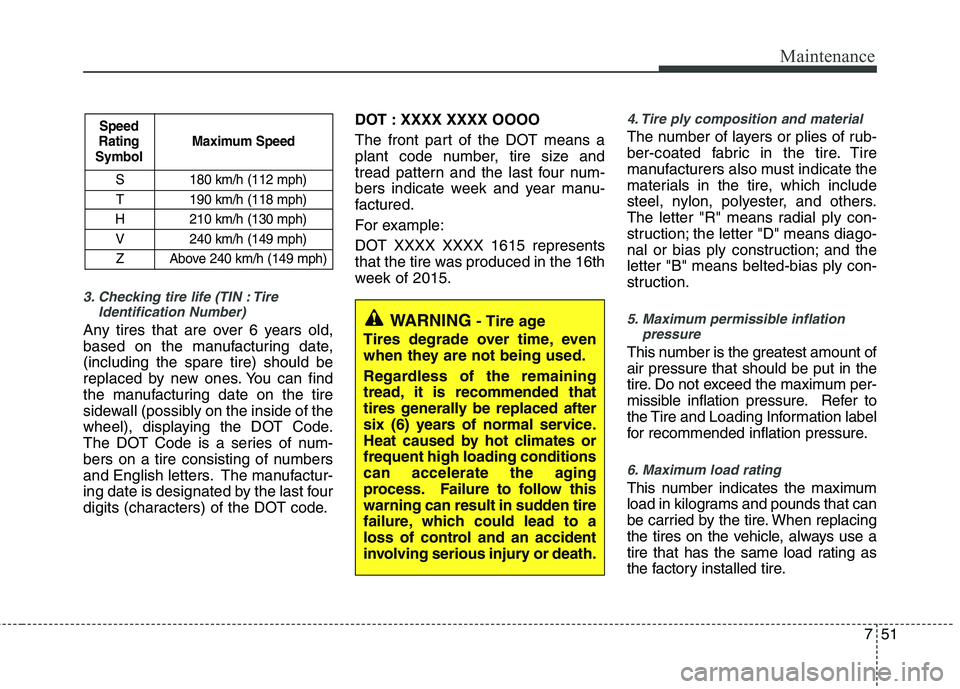
751
Maintenance
3. Checking tire life (TIN : TireIdentification Number)
Any tires that are over 6 years old,
based on the manufacturing date,(including the spare tire) should be
replaced by new ones. You can find
the manufacturing date on the tire
sidewall (possibly on the inside of the
wheel), displaying the DOT Code.
The DOT Code is a series of num-
bers on a tire consisting of numbers
and English letters. The manufactur-
ing date is designated by the last four
digits (characters) of the DOT code. DOT : XXXX XXXX OOOO
The front part of the DOT means a
plant code number, tire size and
tread pattern and the last four num-
bers indicate week and year manu-
factured.
For example:
DOT XXXX XXXX 1615 represents
that the tire was produced in the 16th
week of 2015.
4. Tire ply composition and material
The number of layers or plies of rub-
ber-coated fabric in the tire. Tire
manufacturers also must indicate the
materials in the tire, which include
steel, nylon, polyester, and others.
The letter "R" means radial ply con-
struction; the letter "D" means diago-
nal or bias ply construction; and theletter "B" means belted-bias ply con-
struction.
5. Maximum permissible inflation
pressure
This number is the greatest amount of air pressure that should be put in the
tire. Do not exceed the maximum per-
missible inflation pressure. Refer to
the Tire and Loading Information label
for recommended inflation pressure.
6. Maximum load rating
This number indicates the maximum
load in kilograms and pounds that can
be carried by the tire. When replacing
the tires on the vehicle, always use a
tire that has the same load rating as
the factory installed tire.
S 180 km/h (112 mph)
T 190 km/h (118 mph)
H 210 km/h (130 mph)
V 240 km/h (149 mph) Z Above 240 km/h (149 mph)
Maximum Speed
Speed
Rating
Symbol
WARNING - Tire age
Tires degrade over time, even
when they are not being used.
Regardless of the remaining
tread, it is recommended that
tires generally be replaced after
six (6) years of normal service.
Heat caused by hot climates orfrequent high loading conditions
can accelerate the aging
process. Failure to follow this
warning can result in sudden tire
failure, which could lead to a
loss of control and an accident
involving serious injury or death.
Page 430 of 488

Maintenance
52
7
7. Uniform tire quality grading
Quality grades can be found where
applicable on the tire sidewall
between tread shoulder and maxi-
mum section width.
For example:
TREADWEAR 400
TRACTION A
TEMPERATURE A
Tread wear
The tread wear grade is a compara-
tive rating based on the wear rate ofthe tire when tested under controlled
conditions on a specified govern-
ment test course. For example, a tire
graded 150 would wear one-and-a-
half times (1½) as well on the gov-
ernment course as a tire graded 100.
The relative performance of tires depends upon the actual conditions
of their use, however, and may
depart significantly from the norm
due to variations in driving habits,
service practices and differences in
road characteristics and climate. These grades are molded on the
side-walls of passenger vehicle tires.
The tires available as standard or
optional equipment on your vehicle
may vary with respect to grade.
Traction - AA, A, B & C
The traction grades, from highest to
lowest, are AA, A, B and C. Those
grades represent the tire’s ability to
stop on wet pavement as measuredunder controlled conditions on speci-
fied government test surfaces of
asphalt and concrete. A tire marked C
may have poor traction performance.
Temperature - A, B & C
The temperature grades are A (the
highest), B, and C, representing the
tire’s resistance to the generation ofheat and its ability to dissipate heatwhen tested under controlled condi-
tions on a specified indoor laboratorytest wheel.
Sustained high temperature can
cause the material of the tire to
degenerate and reduce tire life, and
excessive temperature can lead to
sudden tire failure. Grades B and A
represent higher levels of perform-
ance on the laboratory test wheel
than the minimum required by law.
WARNING
The traction grade assigned to this tire is based on straight-ahead braking traction tests,
and does not include accelera-
tion, cornering, hydroplaning,
or peak traction characteristics.WARNING - Tire
temperature
The temperature grade for this
tire is established for a tire that is
properly inflated and not over-
loaded. Excessive speed, under-
inflation, or excessive loading,
either separately or in combina-
tion, can cause heat build-up and
possible sudden tire failure. This
can cause loss of vehicle control
and serious injury or death.
Page 481 of 488
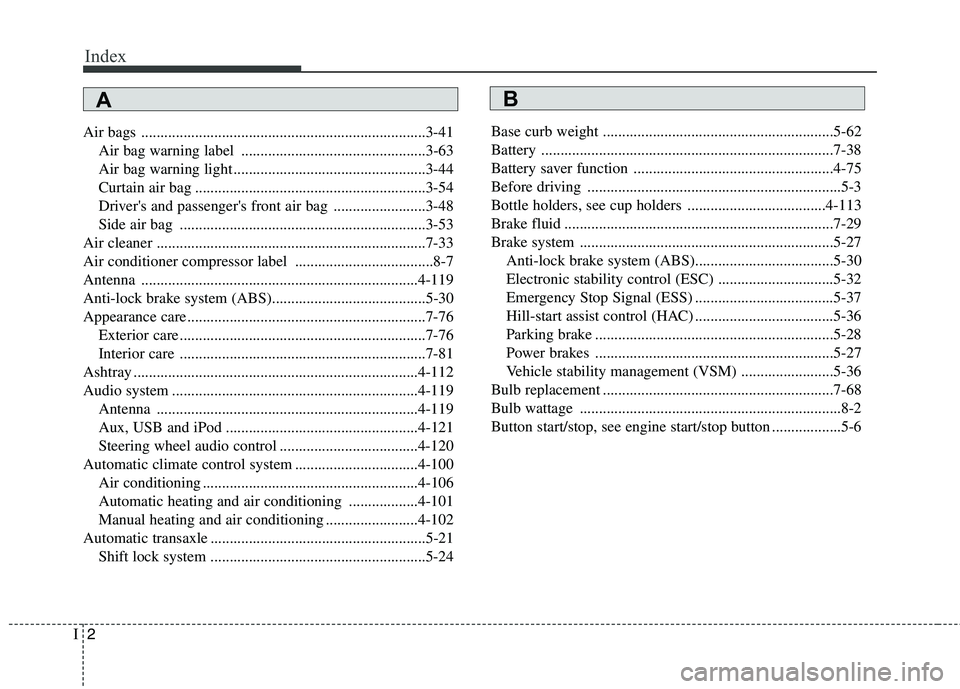
Index
2
I
Air bags ..........................................................................3-41
Air bag warning label ................................................3-63
Air bag warning light ..................................................3-44
Curtain air bag ............................................................3-54
Driver's and passenger's front air bag ........................3-48
Side air bag ................................................................3-53
Air cleaner ......................................................................7-33
Air conditioner compressor label ....................................8-7
Antenna ........................................................................4-119
Anti-lock brake system (ABS)........................................5-30
Appearance care..............................................................7-76 Exterior care ................................................................7-76
Interior care ................................................................7-81
Ashtray ..........................................................................4-112
Audio system ................................................................4-119 Antenna ....................................................................4-119
Aux, USB and iPod ..................................................4-121
Steering wheel audio control ....................................4-120
Automatic climate control system ................................4-100 Air conditioning ........................................................4-106
Automatic heating and air conditioning ..................4-101
Manual heating and air conditioning ........................4-102
Automatic transaxle ........................................................5-21 Shift lock system ........................................................5-24 Base curb weight ............................................................5-62
Battery ............................................................................7-38
Battery saver function ....................................................4-75
Before driving ..................................................................5-3
Bottle holders, see cup holders ....................................4-113
Brake fluid ......................................................................7-29
Brake system ..................................................................5-27
Anti-lock brake system (ABS)....................................5-30
Electronic stability control (ESC) ..............................5-32
Emergency Stop Signal (ESS) ....................................5-37
Hill-start assist control (HAC) ....................................5-36
Parking brake ..............................................................5-28
Power brakes ..............................................................5-27
Vehicle stability management (VSM) ........................5-36
Bulb replacement ............................................................7-68
Bulb wattage ....................................................................8-2
Button start/stop, see engine start/stop button ..................5-6
AB
Page 482 of 488

I3
Index
Capacities (Lubricants) ....................................................8-4 Care
Exterior care ................................................................7-76
Interior care ................................................................7-81
Tire care ......................................................................7-44
Cargo weight ..................................................................5-62
Central door lock switch ................................................4-17
Chains ............................................................................5-59 Tire chains ..................................................................5-59
Changing tires ................................................................6-10
Checking tire inflation pressure ......................................7-45
Child restraint system ....................................................3-30 Lap belt ......................................................................3-34
Lap/shoulder belt ........................................................3-33
with ISOFIX ..............................................................3-35
with Tether anchor ......................................................3-34
Child-protector rear door lock ........................................4-18
Cigarette lighter ............................................................4-112
Climate control air filter ........................................4-98, 7-35
Climate control system (Automatic) ............................4-100 Air conditioning ........................................................4-106
Automatic heating and air conditioning ..................4-101
Manual heating and air conditioning ........................4-102
Climate control system (Manual) ..................................4-91 Air conditioning ..........................................................4-96
Climate control air filter ............................................4-98 Heating and air conditioning ......................................4-92
Clock (Digital) ..............................................................4-116
Clothes hanger ..............................................................4-117
Combined instrument, see instrument cluster ................4-42
Coolant ............................................................................7-26
Cooling fluid, see engine coolant ..................................7-26
Crankcase emission control system ................................7-82
Cruise cotrol system ......................................................5-44
Cup holder ....................................................................4-113
Curtain air bag ................................................................3-54
Dashboard, see instrument cluster ..................................4-42
Daytime running light ....................................................4-75
Declaration of conformity ................................................8-8
Defogging (Windshield) ..............................................4-107
Defogging logic (Windshield) ......................................4-109
Defroster (Rear window) ................................................4-90
Defrosting (Windshield) ..............................................4-108
Digital clock..................................................................4-116
Dimensions ......................................................................8-2
Displays, see instrument cluster ....................................4-42
Door locks ......................................................................4-15 Central door lock switch ............................................4-17
Child-protector rear door lock ....................................4-18
Drink holders, see cup holders ....................................4-113
Driver's air bag ................................................................3-48
C
D